Shilpa and Praful Shah, the Garden Silk Mills people from Surat, are great gourmets and love putting together a table of authentic Surti food for guests when they are entertaining at home in Bombay. They are generous hosts. Their table will be groaning under the weight of the food that their maharajs are cooking in the kitchen. And which, in true Surti fashion, is served hot and fresh. �Surti food is garden fresh, and it is all five to seven minutes� cooking, very few dishes are pre-cooked,� says Praful, who manages the prestigious Garden Silk Mills of Surat with his sons Alok and Suhail, and with Sanjay and Rajan, the sons of his two brothers who have passed away.
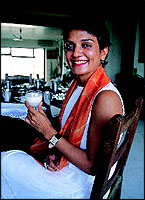 He grew up in Surat before going to US for further studies. Coming back, he worked for sometime with IBM, then joined the family business in 1965. The family business was textiles. It was started in 1921 by his father, Dr. Amichand Shah, an eye surgeon who took up textiles as a side business. First they worked with handlooms, then powerlooms, and from the 1930s onwards it was jaccard looms. In the 1950s, Garden began weaving viscose fabrics that were called artificial silks. Today, Praful runs Garden Vareli (Vareli is a village in Gujarat where the family had farmland they converted into a factory for printing and dyeing) by travelling between Bombay and Surat every week. He travels by train. �The Shatabdi is most convenient, it takes just four hours,� he says.
He grew up in Surat before going to US for further studies. Coming back, he worked for sometime with IBM, then joined the family business in 1965. The family business was textiles. It was started in 1921 by his father, Dr. Amichand Shah, an eye surgeon who took up textiles as a side business. First they worked with handlooms, then powerlooms, and from the 1930s onwards it was jaccard looms. In the 1950s, Garden began weaving viscose fabrics that were called artificial silks. Today, Praful runs Garden Vareli (Vareli is a village in Gujarat where the family had farmland they converted into a factory for printing and dyeing) by travelling between Bombay and Surat every week. He travels by train. �The Shatabdi is most convenient, it takes just four hours,� he says.
 It is a tradition among the members of Surat�s weaving community to sit together at the end of the day and have a light meal. Praful does this whenever he goes to Surat. Everybody, from the proprietor to the marketing, designing, weaving and technical staff come together after work and have a small but proper meal. �It is not like the Surti food I grew up eating in my mother�s kitchen, of course,� he says. �Where we used to eat sitting on the floor on small patlas. And we were served even while she was cooking. Everything was cooked fresh, except the Undhiyu, Papdi and Dal, and this kind of food is best relished. I remember the aroma of the vaghars. Sometimes at home in Bombay, I go into the kitchen and am hit by the aroma of the vaghars. They remind me of my mother�s cooking!�
It is a tradition among the members of Surat�s weaving community to sit together at the end of the day and have a light meal. Praful does this whenever he goes to Surat. Everybody, from the proprietor to the marketing, designing, weaving and technical staff come together after work and have a small but proper meal. �It is not like the Surti food I grew up eating in my mother�s kitchen, of course,� he says. �Where we used to eat sitting on the floor on small patlas. And we were served even while she was cooking. Everything was cooked fresh, except the Undhiyu, Papdi and Dal, and this kind of food is best relished. I remember the aroma of the vaghars. Sometimes at home in Bombay, I go into the kitchen and am hit by the aroma of the vaghars. They remind me of my mother�s cooking!�
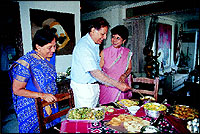 The Shahs do their entertaining at home mostly by serving traditional Surti food. �It is a lot of green vegetables which are cooked in little oil,� says Praful. �The food must look green, then it�s appetising, and this preference comes from the garden fresh vegetables that are grown in South Gujarat. We only use green chillies in our cooking and we sprinkle kothmir on everything.� Wife Shilpa, who personally supervises the kitchen after deciding the menu, is a great cook herself. She believes in seasonal menus and will make sure whatever vegetable is in season reaches the Shah kitchen. �There are shaaks for the summer, karela and jackfruit seeds for the monsoon, and paunk for winter,� she says. �And most of our produce, we get from Surat, Praful or one of the boys brings it down when on one of their weekly trips.� Here she describes what Surti food is all about:
The Shahs do their entertaining at home mostly by serving traditional Surti food. �It is a lot of green vegetables which are cooked in little oil,� says Praful. �The food must look green, then it�s appetising, and this preference comes from the garden fresh vegetables that are grown in South Gujarat. We only use green chillies in our cooking and we sprinkle kothmir on everything.� Wife Shilpa, who personally supervises the kitchen after deciding the menu, is a great cook herself. She believes in seasonal menus and will make sure whatever vegetable is in season reaches the Shah kitchen. �There are shaaks for the summer, karela and jackfruit seeds for the monsoon, and paunk for winter,� she says. �And most of our produce, we get from Surat, Praful or one of the boys brings it down when on one of their weekly trips.� Here she describes what Surti food is all about:
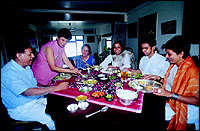 I REMEMBER an amusing incident back in 1967. It was my first trip to Surat as the family�s last daughter-in-law. The ancestral house was run and managed by the eldest daughter-in-law, 20 years my senior, an efficient home-maker and culinary expert. My mother-in-law was quite old by then and had relegated all domestic duties to her oldest daughter-in-law. On the second day after my arrival, I came upstairs � our room was downstairs, and the rest of the family lived upstairs � to see what I should do, and my mother-in-law suggested that I go with the driver to the market for vegetables. This way I will be able to see what is in season and also decide what I may like to eat.
I REMEMBER an amusing incident back in 1967. It was my first trip to Surat as the family�s last daughter-in-law. The ancestral house was run and managed by the eldest daughter-in-law, 20 years my senior, an efficient home-maker and culinary expert. My mother-in-law was quite old by then and had relegated all domestic duties to her oldest daughter-in-law. On the second day after my arrival, I came upstairs � our room was downstairs, and the rest of the family lived upstairs � to see what I should do, and my mother-in-law suggested that I go with the driver to the market for vegetables. This way I will be able to see what is in season and also decide what I may like to eat.
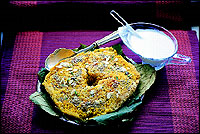 As a Bombay girl, I was not familiar with vegetable markets nor initiated into the art of �buying well�. Sounded like fun. We arrived at the Bhagal Market � there were rows of sellers, and an amazing array of produce was spilling out of their baskets. My eye fell on a woman whose basket looked more striking than the rest. I stood before her, picked up a fistful of papdi, and asked, quite innocently, I thought, �What is the price of this?� She turned her face in contempt and asked me to put it back. �Tamara thi aa nahi levaay.� This is not for you, or you will not be able to afford it. I was stupefied. And humiliated. The audacity of the woman! Back home, my sister-in-law laughed and explained, �These women are proud of what they bring to the market. They would be insulted if their vegetables sold for less than their neighbour�s! They want you to recognise that their produce is fresher, greener and that is why you want them, that price has nothing to do with it!�
As a Bombay girl, I was not familiar with vegetable markets nor initiated into the art of �buying well�. Sounded like fun. We arrived at the Bhagal Market � there were rows of sellers, and an amazing array of produce was spilling out of their baskets. My eye fell on a woman whose basket looked more striking than the rest. I stood before her, picked up a fistful of papdi, and asked, quite innocently, I thought, �What is the price of this?� She turned her face in contempt and asked me to put it back. �Tamara thi aa nahi levaay.� This is not for you, or you will not be able to afford it. I was stupefied. And humiliated. The audacity of the woman! Back home, my sister-in-law laughed and explained, �These women are proud of what they bring to the market. They would be insulted if their vegetables sold for less than their neighbour�s! They want you to recognise that their produce is fresher, greener and that is why you want them, that price has nothing to do with it!�
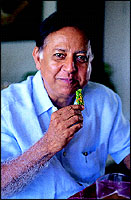 That was a great first lesson. When selecting ingredients for a Surti meal, buying well was all about selecting the freshest. In an hour, it would be served up at the table. Praful�s father was a towering figure in the family, his food quirks and health-food concepts got handed down. The eldest brother would experiment with new flavours of ice-cream and once came up with a delicious ginger ice-cream. The second brother was a great health-food buff. He developed what must have been the country�s first mineral water, way back in 1970 and also set up Surat�s first Health Food Restaurant, making Tofu, whole-wheat brown bread and lots of unusual seasonal greens.
That was a great first lesson. When selecting ingredients for a Surti meal, buying well was all about selecting the freshest. In an hour, it would be served up at the table. Praful�s father was a towering figure in the family, his food quirks and health-food concepts got handed down. The eldest brother would experiment with new flavours of ice-cream and once came up with a delicious ginger ice-cream. The second brother was a great health-food buff. He developed what must have been the country�s first mineral water, way back in 1970 and also set up Surat�s first Health Food Restaurant, making Tofu, whole-wheat brown bread and lots of unusual seasonal greens.
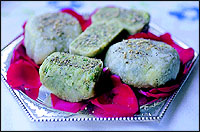 Surtis are partial to greens, and like to include at least one �kaccha-pakka� green seasonal vegetable in each meal. Like Mogri-Chibhda or Kobi-Capsicum or a quick Bhinda nu Shaak where the bhendi is cut small, and cooked on a high flame literally for three-four minutes or a quick Tindola nu Shaak where the tendli is cut in fine round slices. Generally, our greens are brought the same day, since these delicate vegetables and leafy greens do not retain their natural moisture once they are placed in the fridge, so will need more oil and cooking time to break down the hardened fibres. Mostly, round-the-year vegetables like cauliflower and cabbage etc. are less of a problem.
Surtis are partial to greens, and like to include at least one �kaccha-pakka� green seasonal vegetable in each meal. Like Mogri-Chibhda or Kobi-Capsicum or a quick Bhinda nu Shaak where the bhendi is cut small, and cooked on a high flame literally for three-four minutes or a quick Tindola nu Shaak where the tendli is cut in fine round slices. Generally, our greens are brought the same day, since these delicate vegetables and leafy greens do not retain their natural moisture once they are placed in the fridge, so will need more oil and cooking time to break down the hardened fibres. Mostly, round-the-year vegetables like cauliflower and cabbage etc. are less of a problem.
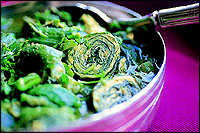 Our green sabzis are mostly cooked in sesame oil (�til� oil) � it makes a subtle but real difference to the taste specially if we are making Undhiyu or Lilva/Papdi. Surat waits for their winter vegetables � the Katargam Papdi arrives on the market in November, opening up the Undhiyu season. Also, green garlic and Paunk. Nowadays, the Bhatha ni Papdi is seen in the market even in summer as people are prepared to pay fancier off season prices.
Our green sabzis are mostly cooked in sesame oil (�til� oil) � it makes a subtle but real difference to the taste specially if we are making Undhiyu or Lilva/Papdi. Surat waits for their winter vegetables � the Katargam Papdi arrives on the market in November, opening up the Undhiyu season. Also, green garlic and Paunk. Nowadays, the Bhatha ni Papdi is seen in the market even in summer as people are prepared to pay fancier off season prices.
Marriage caterers may be responsible! That was not so a few years ago. We plan a meal around two vegetables � one yellow with turmeric and one green � generally we include at least one
seasonal vegetable, as the season passes and that vegetable will not be seen again until the following year. A typical lunch will have Dal (Arhar or Tuar Dal is preferred), Chapattis, two sabzis, a �kachumber� or salad and �chhaash� or butter milk. Dinner is usually Juvar ka Rotla, Kadhi or Osaman (peppered dal-water, like a Gujarati rasam), two sabzis, one sprouted lentil and kachumber.
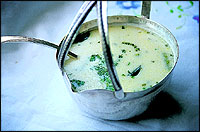 The health conscious modern Surti family nowadays leaves out the fried farsan and the sweet mishtaan. But when guests are over or on special days, it will find its time-honoured place in the Surti thali. As in Gujarati food, all flavours are presented together in the thali � the sweet, the sour, the pungent (pickle) and the bland � and morsels are taken to vary the taste. That is why a Shrikhand or Doodhpaak, a Mango Ras or Sheera is served from the start in a thali. Surtis traditionally like the lighter, fragrant short-grained Kamod variety of rice (our family loves it) for their meals, except when we eat Khichdi and when we use the Kolam. Basmati has entered our larders with the adoption of Pulavs and Biryanis and the mixed-cuisine approach to modern cooking.
The health conscious modern Surti family nowadays leaves out the fried farsan and the sweet mishtaan. But when guests are over or on special days, it will find its time-honoured place in the Surti thali. As in Gujarati food, all flavours are presented together in the thali � the sweet, the sour, the pungent (pickle) and the bland � and morsels are taken to vary the taste. That is why a Shrikhand or Doodhpaak, a Mango Ras or Sheera is served from the start in a thali. Surtis traditionally like the lighter, fragrant short-grained Kamod variety of rice (our family loves it) for their meals, except when we eat Khichdi and when we use the Kolam. Basmati has entered our larders with the adoption of Pulavs and Biryanis and the mixed-cuisine approach to modern cooking.





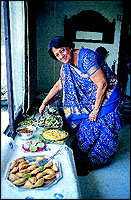 �Garden� Fresh Surti Food!
�Garden� Fresh Surti Food!
 He grew up in Surat before going to US for further studies. Coming back, he worked for sometime with IBM, then joined the family business in 1965. The family business was textiles. It was started in 1921 by his father, Dr. Amichand Shah, an eye surgeon who took up textiles as a side business. First they worked with handlooms, then powerlooms, and from the 1930s onwards it was jaccard looms. In the 1950s, Garden began weaving viscose fabrics that were called artificial silks. Today, Praful runs Garden Vareli (Vareli is a village in Gujarat where the family had farmland they converted into a factory for printing and dyeing) by travelling between Bombay and Surat every week. He travels by train. �The Shatabdi is most convenient, it takes just four hours,� he says.
He grew up in Surat before going to US for further studies. Coming back, he worked for sometime with IBM, then joined the family business in 1965. The family business was textiles. It was started in 1921 by his father, Dr. Amichand Shah, an eye surgeon who took up textiles as a side business. First they worked with handlooms, then powerlooms, and from the 1930s onwards it was jaccard looms. In the 1950s, Garden began weaving viscose fabrics that were called artificial silks. Today, Praful runs Garden Vareli (Vareli is a village in Gujarat where the family had farmland they converted into a factory for printing and dyeing) by travelling between Bombay and Surat every week. He travels by train. �The Shatabdi is most convenient, it takes just four hours,� he says. It is a tradition among the members of Surat�s weaving community to sit together at the end of the day and have a light meal. Praful does this whenever he goes to Surat. Everybody, from the proprietor to the marketing, designing, weaving and technical staff come together after work and have a small but proper meal. �It is not like the Surti food I grew up eating in my mother�s kitchen, of course,� he says. �Where we used to eat sitting on the floor on small patlas. And we were served even while she was cooking. Everything was cooked fresh, except the Undhiyu, Papdi and Dal, and this kind of food is best relished. I remember the aroma of the vaghars. Sometimes at home in Bombay, I go into the kitchen and am hit by the aroma of the vaghars. They remind me of my mother�s cooking!�
It is a tradition among the members of Surat�s weaving community to sit together at the end of the day and have a light meal. Praful does this whenever he goes to Surat. Everybody, from the proprietor to the marketing, designing, weaving and technical staff come together after work and have a small but proper meal. �It is not like the Surti food I grew up eating in my mother�s kitchen, of course,� he says. �Where we used to eat sitting on the floor on small patlas. And we were served even while she was cooking. Everything was cooked fresh, except the Undhiyu, Papdi and Dal, and this kind of food is best relished. I remember the aroma of the vaghars. Sometimes at home in Bombay, I go into the kitchen and am hit by the aroma of the vaghars. They remind me of my mother�s cooking!� The Shahs do their entertaining at home mostly by serving traditional Surti food. �It is a lot of green vegetables which are cooked in little oil,� says Praful. �The food must look green, then it�s appetising, and this preference comes from the garden fresh vegetables that are grown in South Gujarat. We only use green chillies in our cooking and we sprinkle kothmir on everything.� Wife Shilpa, who personally supervises the kitchen after deciding the menu, is a great cook herself. She believes in seasonal menus and will make sure whatever vegetable is in season reaches the Shah kitchen. �There are shaaks for the summer, karela and jackfruit seeds for the monsoon, and paunk for winter,� she says. �And most of our produce, we get from Surat, Praful or one of the boys brings it down when on one of their weekly trips.� Here she describes what Surti food is all about:
The Shahs do their entertaining at home mostly by serving traditional Surti food. �It is a lot of green vegetables which are cooked in little oil,� says Praful. �The food must look green, then it�s appetising, and this preference comes from the garden fresh vegetables that are grown in South Gujarat. We only use green chillies in our cooking and we sprinkle kothmir on everything.� Wife Shilpa, who personally supervises the kitchen after deciding the menu, is a great cook herself. She believes in seasonal menus and will make sure whatever vegetable is in season reaches the Shah kitchen. �There are shaaks for the summer, karela and jackfruit seeds for the monsoon, and paunk for winter,� she says. �And most of our produce, we get from Surat, Praful or one of the boys brings it down when on one of their weekly trips.� Here she describes what Surti food is all about: I REMEMBER an amusing incident back in 1967. It was my first trip to Surat as the family�s last daughter-in-law. The ancestral house was run and managed by the eldest daughter-in-law, 20 years my senior, an efficient home-maker and culinary expert. My mother-in-law was quite old by then and had relegated all domestic duties to her oldest daughter-in-law. On the second day after my arrival, I came upstairs � our room was downstairs, and the rest of the family lived upstairs � to see what I should do, and my mother-in-law suggested that I go with the driver to the market for vegetables. This way I will be able to see what is in season and also decide what I may like to eat.
I REMEMBER an amusing incident back in 1967. It was my first trip to Surat as the family�s last daughter-in-law. The ancestral house was run and managed by the eldest daughter-in-law, 20 years my senior, an efficient home-maker and culinary expert. My mother-in-law was quite old by then and had relegated all domestic duties to her oldest daughter-in-law. On the second day after my arrival, I came upstairs � our room was downstairs, and the rest of the family lived upstairs � to see what I should do, and my mother-in-law suggested that I go with the driver to the market for vegetables. This way I will be able to see what is in season and also decide what I may like to eat. As a Bombay girl, I was not familiar with vegetable markets nor initiated into the art of �buying well�. Sounded like fun. We arrived at the Bhagal Market � there were rows of sellers, and an amazing array of produce was spilling out of their baskets. My eye fell on a woman whose basket looked more striking than the rest. I stood before her, picked up a fistful of papdi, and asked, quite innocently, I thought, �What is the price of this?� She turned her face in contempt and asked me to put it back. �Tamara thi aa nahi levaay.� This is not for you, or you will not be able to afford it. I was stupefied. And humiliated. The audacity of the woman! Back home, my sister-in-law laughed and explained, �These women are proud of what they bring to the market. They would be insulted if their vegetables sold for less than their neighbour�s! They want you to recognise that their produce is fresher, greener and that is why you want them, that price has nothing to do with it!�
As a Bombay girl, I was not familiar with vegetable markets nor initiated into the art of �buying well�. Sounded like fun. We arrived at the Bhagal Market � there were rows of sellers, and an amazing array of produce was spilling out of their baskets. My eye fell on a woman whose basket looked more striking than the rest. I stood before her, picked up a fistful of papdi, and asked, quite innocently, I thought, �What is the price of this?� She turned her face in contempt and asked me to put it back. �Tamara thi aa nahi levaay.� This is not for you, or you will not be able to afford it. I was stupefied. And humiliated. The audacity of the woman! Back home, my sister-in-law laughed and explained, �These women are proud of what they bring to the market. They would be insulted if their vegetables sold for less than their neighbour�s! They want you to recognise that their produce is fresher, greener and that is why you want them, that price has nothing to do with it!� That was a great first lesson. When selecting ingredients for a Surti meal, buying well was all about selecting the freshest. In an hour, it would be served up at the table. Praful�s father was a towering figure in the family, his food quirks and health-food concepts got handed down. The eldest brother would experiment with new flavours of ice-cream and once came up with a delicious ginger ice-cream. The second brother was a great health-food buff. He developed what must have been the country�s first mineral water, way back in 1970 and also set up Surat�s first Health Food Restaurant, making Tofu, whole-wheat brown bread and lots of unusual seasonal greens.
That was a great first lesson. When selecting ingredients for a Surti meal, buying well was all about selecting the freshest. In an hour, it would be served up at the table. Praful�s father was a towering figure in the family, his food quirks and health-food concepts got handed down. The eldest brother would experiment with new flavours of ice-cream and once came up with a delicious ginger ice-cream. The second brother was a great health-food buff. He developed what must have been the country�s first mineral water, way back in 1970 and also set up Surat�s first Health Food Restaurant, making Tofu, whole-wheat brown bread and lots of unusual seasonal greens. Surtis are partial to greens, and like to include at least one �kaccha-pakka� green seasonal vegetable in each meal. Like Mogri-Chibhda or Kobi-Capsicum or a quick Bhinda nu Shaak where the bhendi is cut small, and cooked on a high flame literally for three-four minutes or a quick Tindola nu Shaak where the tendli is cut in fine round slices. Generally, our greens are brought the same day, since these delicate vegetables and leafy greens do not retain their natural moisture once they are placed in the fridge, so will need more oil and cooking time to break down the hardened fibres. Mostly, round-the-year vegetables like cauliflower and cabbage etc. are less of a problem.
Surtis are partial to greens, and like to include at least one �kaccha-pakka� green seasonal vegetable in each meal. Like Mogri-Chibhda or Kobi-Capsicum or a quick Bhinda nu Shaak where the bhendi is cut small, and cooked on a high flame literally for three-four minutes or a quick Tindola nu Shaak where the tendli is cut in fine round slices. Generally, our greens are brought the same day, since these delicate vegetables and leafy greens do not retain their natural moisture once they are placed in the fridge, so will need more oil and cooking time to break down the hardened fibres. Mostly, round-the-year vegetables like cauliflower and cabbage etc. are less of a problem. Our green sabzis are mostly cooked in sesame oil (�til� oil) � it makes a subtle but real difference to the taste specially if we are making Undhiyu or Lilva/Papdi. Surat waits for their winter vegetables � the Katargam Papdi arrives on the market in November, opening up the Undhiyu season. Also, green garlic and Paunk. Nowadays, the Bhatha ni Papdi is seen in the market even in summer as people are prepared to pay fancier off season prices.
Our green sabzis are mostly cooked in sesame oil (�til� oil) � it makes a subtle but real difference to the taste specially if we are making Undhiyu or Lilva/Papdi. Surat waits for their winter vegetables � the Katargam Papdi arrives on the market in November, opening up the Undhiyu season. Also, green garlic and Paunk. Nowadays, the Bhatha ni Papdi is seen in the market even in summer as people are prepared to pay fancier off season prices. The health conscious modern Surti family nowadays leaves out the fried farsan and the sweet mishtaan. But when guests are over or on special days, it will find its time-honoured place in the Surti thali. As in Gujarati food, all flavours are presented together in the thali � the sweet, the sour, the pungent (pickle) and the bland � and morsels are taken to vary the taste. That is why a Shrikhand or Doodhpaak, a Mango Ras or Sheera is served from the start in a thali. Surtis traditionally like the lighter, fragrant short-grained Kamod variety of rice (our family loves it) for their meals, except when we eat Khichdi and when we use the Kolam. Basmati has entered our larders with the adoption of Pulavs and Biryanis and the mixed-cuisine approach to modern cooking.
The health conscious modern Surti family nowadays leaves out the fried farsan and the sweet mishtaan. But when guests are over or on special days, it will find its time-honoured place in the Surti thali. As in Gujarati food, all flavours are presented together in the thali � the sweet, the sour, the pungent (pickle) and the bland � and morsels are taken to vary the taste. That is why a Shrikhand or Doodhpaak, a Mango Ras or Sheera is served from the start in a thali. Surtis traditionally like the lighter, fragrant short-grained Kamod variety of rice (our family loves it) for their meals, except when we eat Khichdi and when we use the Kolam. Basmati has entered our larders with the adoption of Pulavs and Biryanis and the mixed-cuisine approach to modern cooking.